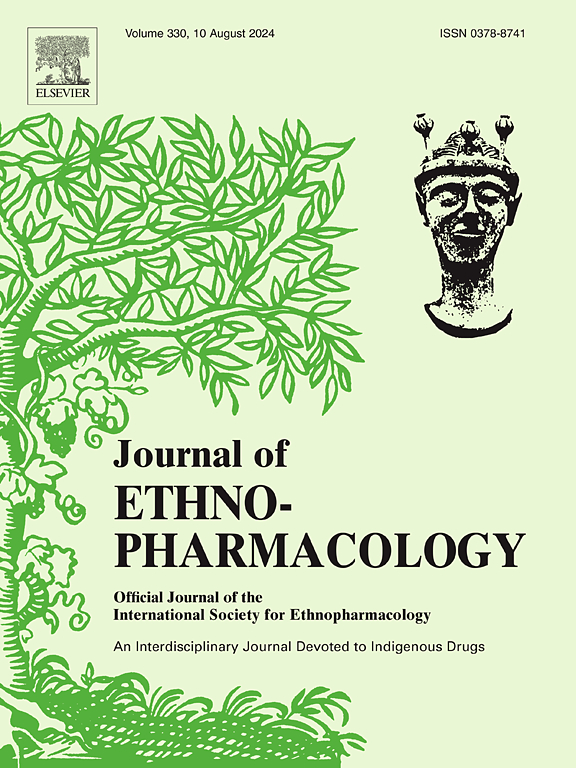Deer sinew with medicine and food homology: A review of traditional efficacy and uses, processing technology, composition, pharmacological effects and application prospects
IF 4.8
2区 医学
Q1 CHEMISTRY, MEDICINAL
引用次数: 0
Abstract
Ethnopharmacological relevance
Deer Sinew, as a kind of precious traditional Chinese medicine, was first recorded in Xin Xiu Ben Cao (Newly Revised Materia Medica). This animal medicine had a long history of ethnomedicinal and food uses, was widely used in the treatment of kidney deficiency and strain, weakness of tendons and bones, rheumatism and paralysis, cold uterus, impotence and nocturnal emissions and so on. However, a systematic review of deer sinews had been lacking.
Aim of the review
The purpose of this paper was to comprehensively review the traditional efficacy and uses, processing techniques, composition, pharmacological effects and application prospects of Deer Sinew. We focused on the traditional medicinal and edible uses of Deer Sinew and so on. In addition, the pharmacological effects of Deer Sinew collagen and its derived peptides and the limitations of Deer Sinew were also discussed.
Methods
This narrative review searched electronic databases including PubMed, Web of Science, Elsevier, SciFinder, China National Knowledge Infrastructure (CNKI), Chinese Masters and Doctoral Dissertations. And other information about Deer Sinew was found in traditional Chinese medical ancient works, local Chinese medicine standards and modern books.
Results
Deer Sinew was recorded in traditional Chinese medical ancient works and modern books, etc. It was a kind of animal medicine with a long history, with the traditional efficacy of tonifying the liver and kidney, strengthening the tendons and bones, and dispelling wind-dampness. Deer Sinew belonged to the medicine and food homology, not only has a high medicinal value, can be combined with other Chinese medicines to form a formula or Chinese patent medicine to prevent and treat many diseases, but also often used in food, the Chinese dietary culture is not lacking in Deer Sinew. Preliminary processing, talcum powder stir-frying, sand stir-frying and so on were typical processing techniques for Deer Sinew. Proteins, amino acids, peptides, collagen, inorganic elements and other related Deer Sinew components have been found. Compared with other components, collagen and its derived peptides have been studied more in modern pharmacology and correspond to traditional efficacy, such as anti-rheumatoid arthritis, anti-osteoporosis and anti-oxidation. In addition, Deer Sinew had a promising application in the fields of medical treatment, food, dietary supplements and cosmetics.
Conclusion
This paper provided a comprehensive review of Deer Sinew and relevant information and theoretical guidance for its future application and development. Modern pharmacological studies provided reliable evidence for traditional efficacy. However, the existing studies have certain limitations and have not been widely and more deeply studied. For this reason, it was necessary to utilize and pass on this valuable animal medicine, Deer Sinew. It is hoped that Deer Sinew will gradually receive more attention and application.

求助全文
约1分钟内获得全文
求助全文
来源期刊

Journal of ethnopharmacology
医学-全科医学与补充医学
CiteScore
10.30
自引率
5.60%
发文量
967
审稿时长
77 days
期刊介绍:
The Journal of Ethnopharmacology is dedicated to the exchange of information and understandings about people''s use of plants, fungi, animals, microorganisms and minerals and their biological and pharmacological effects based on the principles established through international conventions. Early people confronted with illness and disease, discovered a wealth of useful therapeutic agents in the plant and animal kingdoms. The empirical knowledge of these medicinal substances and their toxic potential was passed on by oral tradition and sometimes recorded in herbals and other texts on materia medica. Many valuable drugs of today (e.g., atropine, ephedrine, tubocurarine, digoxin, reserpine) came into use through the study of indigenous remedies. Chemists continue to use plant-derived drugs (e.g., morphine, taxol, physostigmine, quinidine, emetine) as prototypes in their attempts to develop more effective and less toxic medicinals.
 求助内容:
求助内容: 应助结果提醒方式:
应助结果提醒方式:


